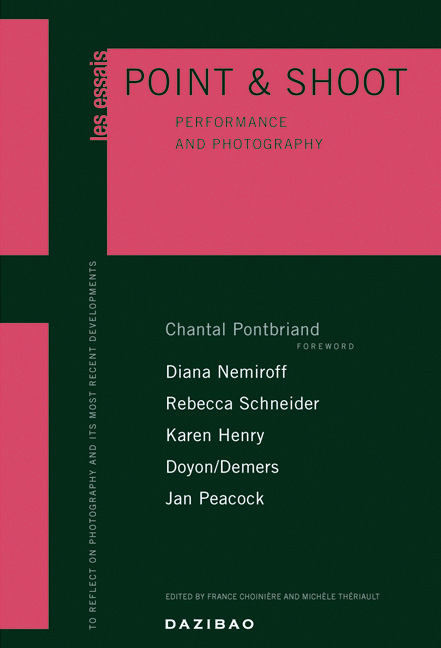[Summer 2006]
Point & Shoot
Performance and Photography
edited by France Choinière et Michèle Thériault
Éditions Dazibao
2005
The latest in Galerie Dazibao’s series of publications on “hybrid” photographic practices introduces a timely subject: the relationship between photography and performance in Canadian art. Presented from both historical and theoretical perspectives, the collection of writings attempts to clarify a dominant trend in contemporary photography that fuses theatre, video, and the still image. The book accompanies the two exhibitions and day of performances held at Galerie Dazibao and other locations in Montreal in the spring of 2004. The generously illustrated and handsomely designed pocket-sized book is thick with information, theoretical analysis, and lyrical musings. The editors (France Choinière, director of Galerie Dazibao, and Michèle Thériault, director of the Leonard and Bina Ellen Gallery) have assembled texts that provide a comprehensive and succinct review of the topic. As they say in the introduction, the book’s focus is cast “just beyond the most obvious link” – that is, past the instrumental bond that unites photography and performance.
In the foreword, Chantal Pontbriand (founder and editor of Parachute Magazine), whose writings on performance of the early 1980s are as relevant today as they were prescient in their time, offers remarks on the essential “triad” formed by “body, photography, performance.” In an essay likely influenced by Rosalind Krauss, she reflects on the “caesura in time and space” presented by nineteenth-century photographer Félix Nadar’s Pierrot (a clown type). These images, she writes, illustrate photography’s constructed reality or “photography effect,” a phrase first coined by Roland Barthes. Pontbriand suggests that the enigmatic images are conceptually and historically linked to the mise-en-scène or “staging of the body,” necessary to many of the photography-based artists working today. These artists, as diverse as Jeff Wall and Geneviève Cadieux, explore the “stasis” of photographic reality rather than its objects.
The following essay, by Diana Nemiroff, is a review of the video art scenes of Montreal and Toronto in the 1960s and 1970s, which, she proposes, form the antecedent to recent photographic practice. Previously curator of contemporary art at the National Gallery of Canada, she has returned to a period that she first masterfully examined as an art-history graduate. Nemiroff attributes the link between performance and photography to two critical influences: the advent of media theory (McLuhan) and the impact of French structuralism (Barthes et al.). Together, these theoretical perspectives highlight the “commodification of art” and the “mediating effects of the media itself,” which artists first exploited and later resisted. The “inherently discursive character” of photography and video allowed artists to strategically deploy new media in order to emphasize immediacy and spontaneity as well as artifice and irony. Nemiroff’s essay is clearly meant to supply the “Canadian art history” background to the book, but its ambitious intentions deserved more space or more careful editing.
Rebecca Schneider’s short essay is a reprieve from the dense text that precedes it. A writer on theatre and performance studies, she offers the long view, bringing the subject of photography and performance to its historical origins in tableau vivant. She explores what Pontbriand touches on : the ontological divide between life and death presented by the moving vs. the motionless body. She, too, turns to Barthes and, appropriately, to Benjamin’s and Kernodle’s writings on theatre. Schneider’s brief historical tour of the tableaux vivant presents a challenging supplement to the more usual discussions that limit historical analysis of the “still living” image to technological – that is, videographic – influences alone.
The formative period of the 1960s and 1970s is also addressed in Karen Henry’s text which uses Allan Kaprow as its historical model and then moves “fast forward” to Vancouver artist Judy Radul. Kaprow’s and Michael Fried’s competing ideas on theatricality in art establish Henry’s theoretical focus. She traces Radul’s work to earlier conceptual-art practices that addressed the nature of mediated sight and the integration of the viewer into the art process. Stricter editing would have helped Henry’s writing, in which generalizations such as “the 1960s were the apex of post-war idealism” and “Kaprow was probably [sic] influenced by Buddhism,” serve little purpose.
The performance group Doyon/Demers (Hélène Doyon and Jean-Pierre Demers) also turn to Kaprow using his notion of the “un-artist” as the starting point for their critical observations on the current generation of artists who are working in the context of “cultural democracy.” Like the earlier situationists (and their theorists), Fluxus, or N.E.Thing Co. Ltd., artists such as Doyon/Demers use new technologies and aggressive strategies to “infiltrate” the globalizing effect of market forces. Their discussion of today’s most powerful tool, the World Wide Web, is indispensable to the book’s overall argument, which repeatedly refers to the symbiotic relationship between art and technology.
It is with delight that one encounters Jan Peacock’s “Presence” as the final essay. It is a thoughtful and moving reflection on her video piece Midnight Reader. Drawing on works by Paula Levine and Alison Rossiter, she revisits the piece from within the contemplative space of mourning. The “liveness” of video, she tells us, drags memory through the world of once useful things now illuminated like relics from a receding past. Her writing is assured and as fluid as a “line of light.”
While many of the book’s supporting illustrations are so small that they benefit page-layout design more than they showcase individual artists’ works, they nevertheless remind the reader that the book accompanied exhibitions and performances by over twenty artists. The introduction and the brief artists’ biographies place the images in perspective. Some of the artists are internationally known, such as Vito Acconci and Arnulf Rainer; others are familiar names drawn from Vancouver and Toronto, such as Max Dean, Suzy Lake, and Paul Wong. Many are new to Canadian audiences, with a majority of these working out of Montreal; they include Sylvie Cotton, Adad Hannah, and Chih-Chien Wang, along with several other rising artists.
Anna Carlevaris lives and works in Montreal.

